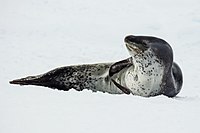
Photo from wikipedia
The foraging behaviors of apex predators can fundamentally alter ecosystems through cascading predator–prey interactions. Food caching is a widely studied, taxonomically diverse behavior that can modify competitive relationships and affect… Click to show full abstract
The foraging behaviors of apex predators can fundamentally alter ecosystems through cascading predator–prey interactions. Food caching is a widely studied, taxonomically diverse behavior that can modify competitive relationships and affect population viability. We address predictions that food caching would not be observed in the marine environment by summarizing recent caching reports from two marine mammal and one marine reptile species. We also provide multiple caching observations from disparate locations for a fourth marine predator, the leopard seal (Hydrurga leptonyx (de Blainville, 1820)). Drawing from consistent patterns in the terrestrial literature, we suggest the unusual diversity of caching strategies observed in leopard seals is due to high variability in their polar marine habitat. We hypothesize that caching is present across the spectrum of leopard seal social dominance; however, prevalence is likely to increase in smaller, less-dominant animals that hoard to gain competitive advantage. Given the importance of this behavior, we draw attention to the high probability of observing food caching behavior in other marine species.
Journal Title: Canadian Journal of Zoology
Year Published: 2019
Link to full text (if available)
Share on Social Media: Sign Up to like & get
recommendations!